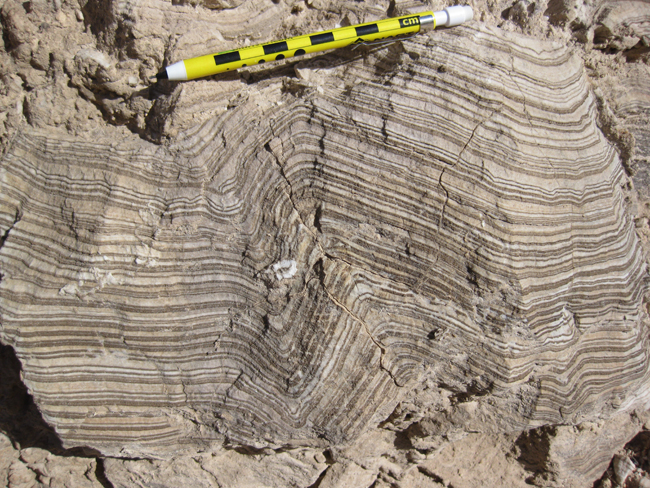20 June 2014
Friday fold: the Castile Formation at the State line outcrop
Posted by Callan Bentley
One of the real treats of the spring break field course in west Texas was visiting a road cut of the Castile Formation, a Permian evaporite formation south of the Guadalupe Mountains. It’s on the border between Texas and New Mexico, and I’d been wanting to see it for years after seeing a photo of the folds there in a structural geology paper about folding.

The strata of the Castile Formation are gypsum/anhydrite (the white layers) and organic-rich limestone (the dark layers). They are thought to represent changes in the salinity of the basin in which the strata were deposited (the Delaware Basin). The regular periodicity of the alternation of sediment type suggests some sort of rhythmic influence on the salinity of the basin, and many workers interpreted theses black and white layers as varves – seasonal deposits.
But it’s probably a more complicated story than just “seasons only” – as there are anomalously thick layers interspersed throughout:

But we didn’t come here for the layers themselves. We came to see their high-contrast outcrop pattern when folded. Though this post runs the risk of overwhelming you with gorgeous fold imagery, I’m going to just let loose the avalanche:
























And, why not, let’s finish this feast with a single fault example:




 Callan Bentley is Associate Professor of Geology at Piedmont Virginia Community College in Charlottesville, Virginia. He is a Fellow of the Geological Society of America. For his work on this blog, the National Association of Geoscience Teachers recognized him with the James Shea Award. He has also won the Outstanding Faculty Award from the State Council on Higher Education in Virginia, and the Biggs Award for Excellence in Geoscience Teaching from the Geoscience Education Division of the Geological Society of America. In previous years, Callan served as a contributing editor at EARTH magazine, President of the Geological Society of Washington and President the Geo2YC division of NAGT.
Callan Bentley is Associate Professor of Geology at Piedmont Virginia Community College in Charlottesville, Virginia. He is a Fellow of the Geological Society of America. For his work on this blog, the National Association of Geoscience Teachers recognized him with the James Shea Award. He has also won the Outstanding Faculty Award from the State Council on Higher Education in Virginia, and the Biggs Award for Excellence in Geoscience Teaching from the Geoscience Education Division of the Geological Society of America. In previous years, Callan served as a contributing editor at EARTH magazine, President of the Geological Society of Washington and President the Geo2YC division of NAGT.
Amazing parasitic folds! I am really surprised with some of the picts in which there is quite a difference in frequency among the layers !
Where is this outcrop?
Here, -ish:
I have trouble trying to balance my coveting such stone, wanting a house built of it, and a strong conservationist-bent, wanting to protect it.
Gotta let it alone.
Like I could afford it.
Magnanimous of me to “leave it alone”…
This looks like it could inspire pottery patterns. Thanks for the eye-feast.